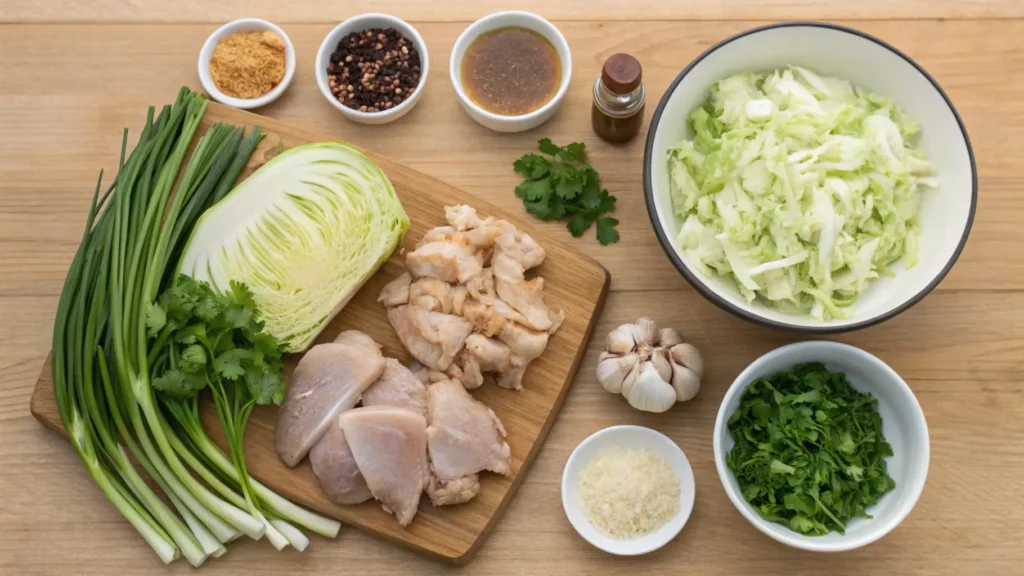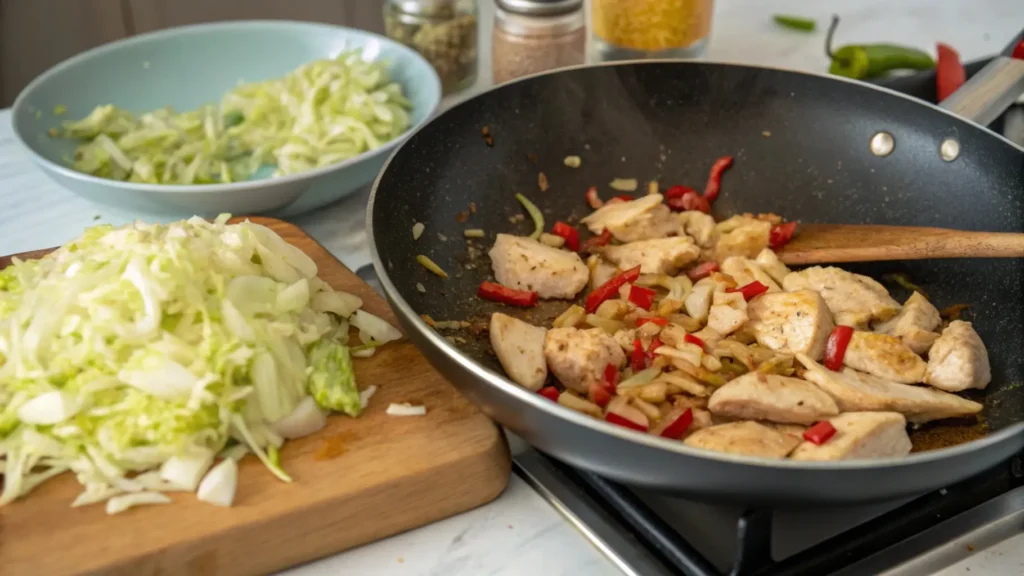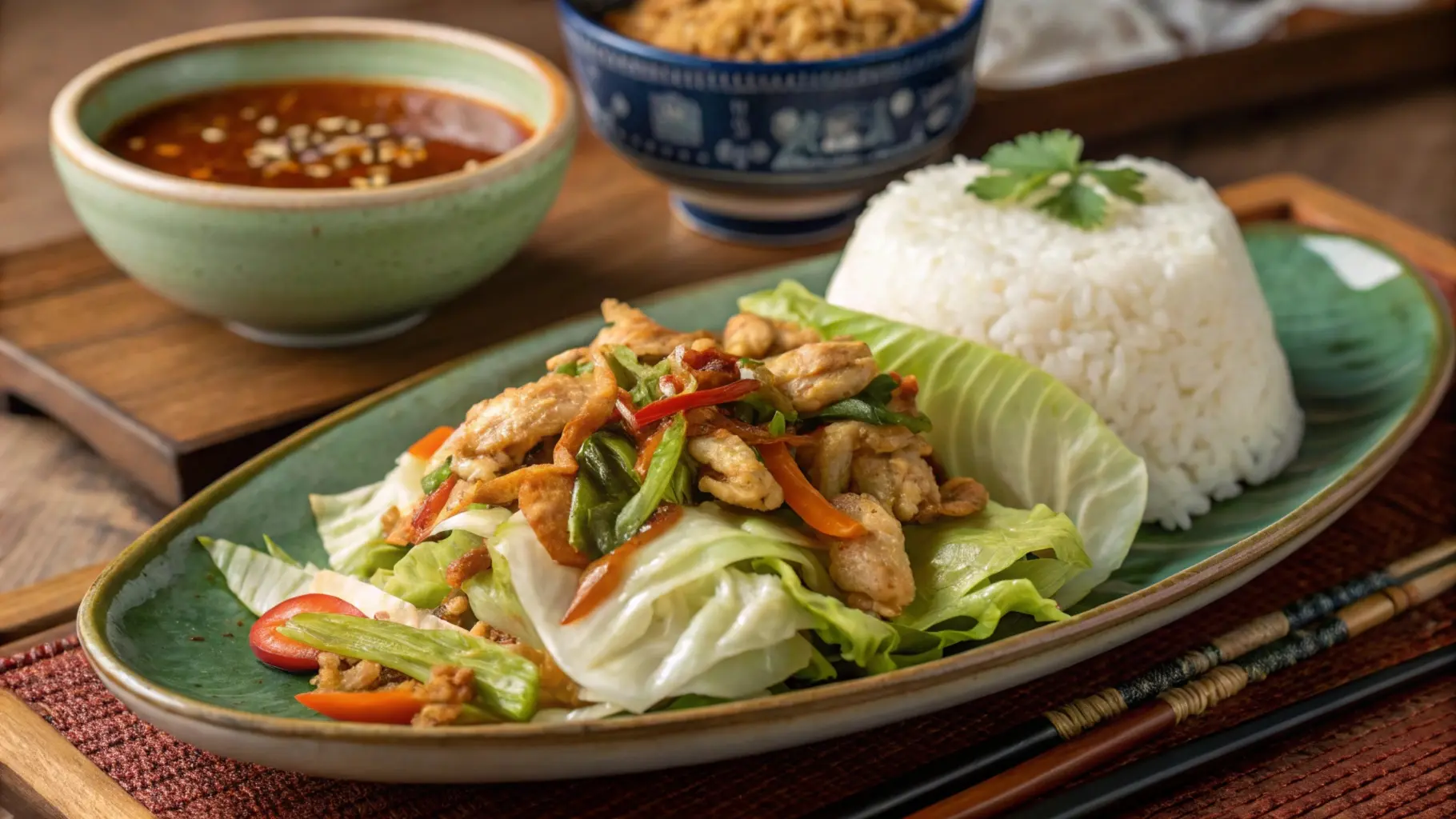Hmong cuisine is a treasure trove of bold flavors, fresh ingredients, and simple yet satisfying recipes. At the heart of this culinary tradition is the Hmong cabbage and chicken recipe—a dish that combines tender chicken, crisp cabbage, and aromatic spices into a savory masterpiece. Whether you’re a seasoned cook or a curious beginner, this guide will walk you through the steps to create an authentic Hmong meal right in your kitchen. From the rich history of Hmong cooking to preparation tips, cooking techniques, and serving ideas, you’ll find everything you need to master this beloved recipe.
Introduction to Hmong Cuisine
Hmong Cuisine and Its Signature Recipes
Hmong cuisine is deeply rooted in the culture and lifestyle of the Hmong people, known for their agricultural heritage and harmonious connection to nature. Traditional recipes often revolve around fresh, seasonal ingredients sourced directly from the land. Simple cooking methods like stir-frying, steaming, and boiling bring out the natural flavors of the ingredients, resulting in dishes that are both nourishing and flavorful.
The Hmong cabbage and chicken recipe exemplifies this balance of simplicity and taste. It’s a testament to the Hmong people’s resourcefulness and creativity in crafting meals that are as rich in history as they are in flavor. This dish reflects the importance of family-style dining, where food is shared and enjoyed together.
Why Hmong Cabbage and Chicken Recipe Is a Classic Dish
Cabbage and chicken hold a special place in Hmong cooking. Cabbage, with its subtle sweetness and crunchy texture, pairs perfectly with the tender, juicy chicken to create a balanced dish that satisfies on every level. Chicken is often chosen for its versatility, ease of preparation, and ability to absorb bold flavors from spices and sauces.
Together, these ingredients form the foundation of a dish that’s not only delicious but also highly adaptable. Whether paired with steamed rice, blanched vegetables, or spicy Hmong pepper dip, the Hmong cabbage and chicken recipe is a crowd-pleaser that brings people together at the dinner table.
Ingredients for Hmong Cabbage and Chicken Recipe

Essential Ingredients for the Perfect Hmong Cabbage and Chicken Recipe
To create an authentic Hmong cabbage and chicken recipe, you’ll need a few staple ingredients that pack a punch of flavor. At the heart of this dish are chicken thighs—bone-in and skin-on for maximum taste. The skin is often crisped up separately to add texture and richness. Cabbage, the star vegetable, is chosen for its mild sweetness and crunch. Together, they form a harmonious base that’s enhanced by aromatic ginger, garlic, and onions.
Additional ingredients like fresh chili peppers, cilantro, and green onions give this recipe its signature boldness. For seasoning, a mix of salt, oyster sauce, and chicken bouillon helps balance the flavors. Each component works together to create a dish that’s as wholesome as it is satisfying.
Fresh Ingredients for Authentic Hmong Chicken and Cabbage Flavor
Freshness is a cornerstone of Hmong cuisine. Using fresh cabbage ensures a crisp texture that holds up during cooking, while fresh ginger adds a fiery warmth that’s hard to replicate with dried alternatives. The chicken, ideally sourced from a local butcher or market, brings depth and richness to the dish.
By prioritizing fresh produce and meats, you’ll elevate the flavors of your Hmong cabbage and chicken recipe and stay true to its roots in Hmong culinary tradition.
Optional Ingredients to Customize Your Hmong Chicken Dish
Want to customize the recipe? Consider adding bok choy or kale as an alternative to cabbage for a slightly different twist. Prefer less heat? Swap out the fresh chili peppers for mild bell peppers. You can also drizzle a little sesame oil at the end for a nutty aroma. These small tweaks allow you to adapt the dish while keeping its authentic spirit intact.
Step-by-Step Preparation Guide

Preparing the Chicken and Cabbage
The first step in making the perfect Hmong cabbage and chicken recipe is prepping your ingredients. Start by removing the bones from the chicken thighs and cutting the meat into bite-sized pieces. Don’t toss the skin—it’ll be crisped up later for garnish! Season the chicken with salt and a pinch of chicken bouillon for an extra layer of flavor.
Next, prepare the cabbage. Chop it into medium-sized pieces so it retains some crunch when cooked. Having your vegetables and chicken prepped ahead of time makes the cooking process much smoother.
Making Crispy Chicken Skin for Garnish
For that irresistible crunch, fry the chicken skin before cooking the rest of the dish. Heat a pan over medium heat and add the chicken skin with a sprinkle of salt. Let it render its fat, turning golden and crispy. Once done, set it aside to drain on a paper towel. The rendered fat can be used for stir-frying the other ingredients, adding an extra depth of flavor to the dish.
Assembling the Recipe with Ginger and Aromatics
Now comes the fun part—bringing everything together! Heat two tablespoons of the reserved chicken fat in a wok or large skillet. Add the chopped chicken and sear it on high heat until golden brown. Push the chicken to one side, then toss in minced garlic and julienned ginger. Sauté until fragrant, then mix everything together.
Add the cabbage and onions next, stirring them in until they soften slightly but still retain a bit of crunch. Finally, stir in oyster sauce and adjust the seasoning to taste. Finish the dish by adding chopped green onions, cilantro, and optional chili peppers for a burst of color and flavor. Garnish with crispy chicken skin just before serving.
Cooking Techniques for Authentic Flavor
Essential Hmong Stir-Frying Methods
Stir-frying is at the heart of many traditional Hmong dishes, including the Hmong cabbage and chicken recipe. This method not only locks in the flavors of the ingredients but also preserves their nutritional value. To achieve authentic Hmong flavors, it’s crucial to use a wok or a large skillet, as the wide surface area allows for even cooking.
Start by heating the pan until it’s hot, then add a small amount of oil or rendered chicken fat. This ensures that your ingredients cook quickly and don’t stick to the pan. Stir frequently to prevent burning, but let the ingredients sit for a few seconds occasionally to develop a nice sear.
Adjusting Heat and Timing for Perfection
Temperature control is key to getting the best results in stir-frying. Begin on high heat to sear the chicken and develop deep flavors. Once the meat is browned, reduce the heat slightly before adding aromatics like garlic and ginger. This ensures they don’t burn and ruin the dish’s taste.
As for the cabbage, cook it just long enough to retain some crunch. Overcooking it can make the dish soggy and dull. By mastering these heat adjustments, you’ll create a Hmong cabbage and chicken recipe that’s bursting with texture and flavor.
Key Tips for Balancing Aromatic Herbs and Spices
The use of fresh ginger, garlic, and green onions is a hallmark of Hmong cooking. These aromatics add depth and complexity to the dish. To balance their bold flavors, incorporate a touch of oyster sauce and chicken bouillon. If you’re a spice lover, toss in some chili peppers for a kick. The result? A dish that’s savory, aromatic, and utterly irresistible.
Serving Suggestions and Complements
Pairing the Dish with Hmong-Style Pepper Dip
No Hmong cabbage and chicken recipe is complete without a side of spicy Hmong pepper dip. This condiment, made with fresh chili peppers, garlic, and lime juice, adds a tangy heat that elevates the dish. Serve it in a small bowl on the side for guests to customize their spice level.
Serving with Steamed Rice and Blanched Vegetables
The simplicity of steamed rice is the perfect complement to the bold flavors of this recipe. Its mild, fluffy texture balances the richness of the chicken and the crunch of the cabbage. For a healthier twist, serve the dish with brown rice or quinoa.
Blanched vegetables like bok choy or broccoli make excellent side dishes. Their freshness and mild flavor harmonize with the aromatic notes of the stir-fry. Lightly season them with salt or drizzle a bit of sesame oil for added flavor.
Presentation Tips for a Traditional Hmong Meal
Presentation matters when serving a traditional Hmong dish. Arrange the cabbage and chicken on a platter, topped with crispy chicken skin for an appealing crunch. Garnish with fresh cilantro and green onions for a pop of color. Place the platter at the center of the table, surrounded by rice, pepper dip, and vegetables, encouraging family-style dining that’s central to Hmong culture.
Nutritional Benefits of Hmong Cabbage and Chicken Recipe
Health Advantages of Cabbage and Chicken
The Hmong cabbage and chicken recipe is not just flavorful but also packed with nutritional benefits. Cabbage, a cruciferous vegetable, is low in calories yet rich in vitamins C and K, making it a great addition to any balanced diet. It’s also high in antioxidants, which support overall health and help reduce inflammation.
Chicken, especially when prepared with lean cuts like thighs, is an excellent source of high-quality protein. It promotes muscle repair and provides essential nutrients like selenium and B vitamins. Combining chicken with cabbage creates a dish that’s hearty and wholesome, perfect for a family meal.
Low-Calorie and High-Protein Attributes
One of the reasons this dish is so popular is its low-calorie yet high-protein profile. Unlike recipes that rely on heavy sauces, the Hmong cabbage and chicken recipe uses minimal oil and simple seasonings, keeping it light and healthy. The natural flavors of ginger, garlic, and cilantro enhance the dish without adding extra calories. This makes it an ideal option for those looking to maintain or lose weight without sacrificing taste.
Incorporating Ginger for Its Medicinal Properties
Ginger plays a dual role in this recipe: it adds a warm, zesty flavor and offers numerous health benefits. Known for aiding digestion and boosting immunity, ginger is a vital component of this nutritious dish. Including it in your meals can promote gut health and provide anti-inflammatory effects.
Common Variations of the Recipe
Using Other Vegetables Like Bok Choy or Kale
Cabbage is the traditional vegetable for this recipe, but alternatives like bok choy or kale work just as well. Bok choy’s tender leaves and crisp stems provide a delicate texture, while kale’s earthy flavor adds depth. These substitutes allow you to customize the dish based on what’s in season or readily available.
Adapting Seasonings for Personal Preferences
Every cook has their unique twist, and this recipe is no exception. If you enjoy stronger flavors, you can add a splash of soy sauce or fish sauce for a savory punch. Prefer less heat? Skip the chili peppers and use sweet bell peppers instead. These adjustments make the Hmong cabbage and chicken recipe versatile enough to fit any palate while maintaining its traditional roots.
FAQs About Hmong Cabbage and Chicken Recipe
What Makes Hmong Cabbage and Chicken Unique?
The Hmong cabbage and chicken recipe stands out because of its simplicity and bold, fresh flavors. Unlike many stir-fries that rely on heavy sauces, this dish uses minimal seasoning, letting the natural taste of the ingredients shine. The combination of tender chicken, crunchy cabbage, and fragrant aromatics like ginger and garlic gives it an unmistakable, hearty flavor. Plus, the crispy chicken skin garnish adds an irresistible texture that elevates the dish.
Can I Use Pre-Cooked Chicken for This Recipe?
Yes, pre-cooked chicken can be used, but the flavor may not be as rich. The traditional recipe relies on rendering chicken fat during cooking, which deepens the dish’s taste. If you’re using pre-cooked chicken, consider adding a little chicken stock or extra oyster sauce to compensate for the lost depth of flavor.
What Are Good Substitutes for Ginger?
If ginger is unavailable or you prefer a milder flavor, you can use galangal or lemongrass as substitutes. Both offer a unique aroma that complements the dish. For a completely different twist, grated turmeric root can provide an earthy and slightly spicy note.
Is This Recipe Suitable for Meal Prep?
Absolutely! The Hmong cabbage and chicken recipe stores well and reheats beautifully. Prepare a large batch, divide it into meal-sized portions, and store it in the fridge for up to four days. Pair it with fresh rice for a quick and delicious meal any day of the week.
Conclusion
The Hmong cabbage and chicken recipe is a true celebration of Hmong culinary traditions. Its vibrant flavors, fresh ingredients, and comforting simplicity make it a dish worth adding to your meal rotation. From the crispy chicken skin garnish to the bold kick of ginger and chili, every element contributes to an unforgettable dining experience. Whether you’re recreating it for a family dinner or introducing friends to Hmong cuisine, this recipe is sure to impress. So, gather your ingredients, follow this guide, and enjoy the authentic flavors of a classic Hmong dish in your own kitchen.

